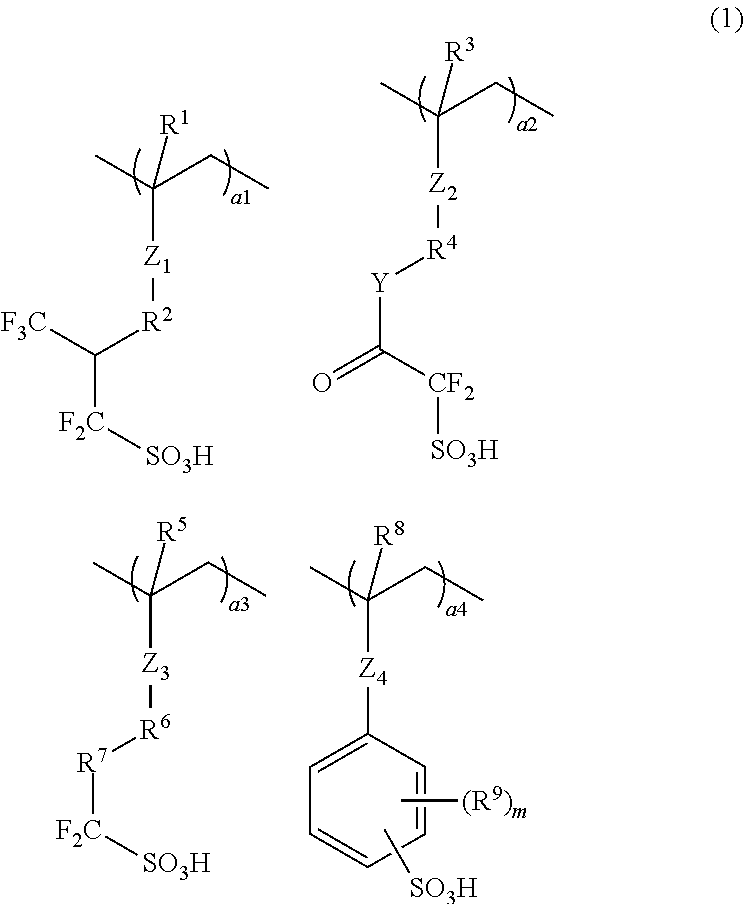Conductive material and substrate
a technology of conductive materials and substrates, applied in the direction of electrically conductive paints, non-metal conductors, organic conductors, etc., can solve the problems of poor conductivity and generating dark spots, and achieve excellent conductivity and transparency, good filterability and film-formability, and good conductivity. , good conductivity and transparency
- Summary
- Abstract
- Description
- Claims
- Application Information
AI Technical Summary
Benefits of technology
Problems solved by technology
Method used
Image
Examples
examples
[0118]Hereinafter, the present invention will be specifically described with reference to Synthesis Examples, Preparation Examples, Comparative Preparation Examples, Examples, and Comparative Examples, but the present invention is not restricted thereto.
synthesis examples 1 to 9
[0119]Under nitrogen atmosphere, a solution in which each monomer and dimethyl 2,2′-azobis(isobutyrate) had been mixed into methanol stirred at 64° C. was stirred for 8 hours. After cooling to room temperature, the mixture was added dropwise to ethyl acetate under vigorous stirring. The resulting solid was collected by filtration, and dried under vacuum at 50° C. for 15 hours to obtain a white polymer. The obtained white polymer was dissolved in pure water, and a cation of the monomer was substituted to a hydrogen atom by ion-exchange resin, and thereby changed to a sulfo group.
[0120]In such a method, the following dopant polymers 1 to 9 were synthesized.
[0121]Weight-average molecular weight (Mw)=29,900
[0122]Molecular weight distribution (Mw / Mn)=1.91
[0123]Weight-average molecular weight (Mw)=31,000
[0124]Molecular weight distribution (Mw / Mn)=1.89
Dopant Polymer 3
[0125]Weight-average molecular weight (Mw)=24,000
[0126]Molecular weight distribution (Mw / Mn)...
preparation example 1
[0139]A solution in which 12.5 g of Dopant polymer 1 had been dissolved in 1,000 mL of ultrapure water was mixed with 3.82 g of 3,4-ethylenedioxythiophene at 30° C.
[0140]Into the resulting mixed solution was slowly added an oxidation catalyst solution in which 8.40 g of sodium persulfate and 2.3 g of ferric sulfate had been dissolved in 100 mL of ultrapure water while stirring the mixed solution and keeping the temperature thereof at 30° C., and the reaction was carried out for 4 hours under stirring.
[0141]Into the reaction solution thus obtained was added 1,000 mL of ultrapure water, and about 1,000 mL of the solution was removed by ultrafiltration. This procedure was repeated 3 times.
[0142]Subsequently, 200 mL of sulfuric acid diluted to 10% by mass and 2,000 mL of ion-exchanged water were added to the solution treated with the ultrafiltration, and about 2,000 mL of the treated solution was removed by ultrafiltration; then, 2,000 mL of ion-exchanged water was added thereto, and ab...
PUM
| Property | Measurement | Unit |
|---|---|---|
| absorption at a wavelength | aaaaa | aaaaa |
| temperature | aaaaa | aaaaa |
| reaction time | aaaaa | aaaaa |
Abstract
Description
Claims
Application Information
 Login to View More
Login to View More - R&D
- Intellectual Property
- Life Sciences
- Materials
- Tech Scout
- Unparalleled Data Quality
- Higher Quality Content
- 60% Fewer Hallucinations
Browse by: Latest US Patents, China's latest patents, Technical Efficacy Thesaurus, Application Domain, Technology Topic, Popular Technical Reports.
© 2025 PatSnap. All rights reserved.Legal|Privacy policy|Modern Slavery Act Transparency Statement|Sitemap|About US| Contact US: help@patsnap.com



